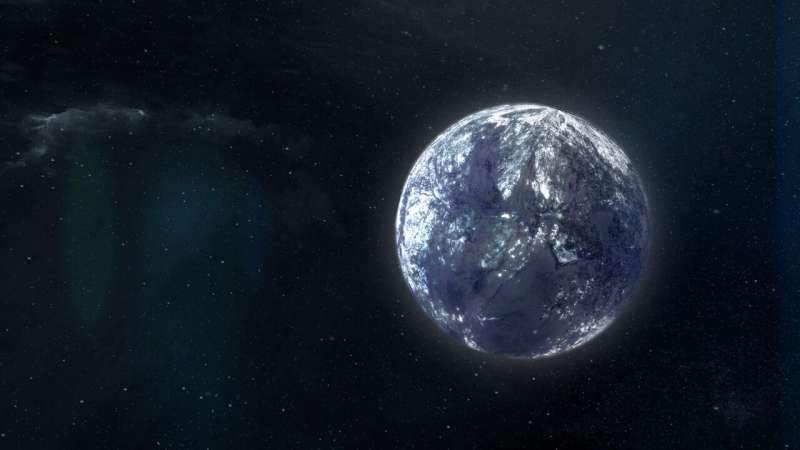This article has been reviewed according to Science X's editorial process and policies. Editors have highlighted the following attributes while ensuring the content's credibility:
fact-checked
peer-reviewed publication
trusted source
proofread
New study reveals NASA's Roman could find 400 Earth-mass rogue planets

New research by scientists from NASA and Japan's Osaka University suggests that rogue planets—worlds that drift through space untethered to a star—far outnumber planets that orbit stars. The results imply that NASA's Nancy Grace Roman Space Telescope, set to launch by May 2027, could find a staggering 400 Earth-mass rogue worlds. Indeed, this new study has already identified one such candidate.
"We estimate that our galaxy is home to 20 times more rogue planets than stars—trillions of worlds wandering alone," said David Bennett, a senior research scientist at NASA's Goddard Space Flight Center in Greenbelt, Maryland, and a co-author of two papers describing the results. "This is the first measurement of the number of rogue planets in the galaxy that is sensitive to planets less massive than Earth."
The team's findings stem from a nine-year survey called MOA (Microlensing Observations in Astrophysics), conducted at the Mount John University Observatory in New Zealand. Microlensing events occur when an object such as a star or planet comes into near-perfect alignment with an unrelated background star from our vantage point.
Because anything with mass warps the fabric of space-time, light from the distant star bends around the nearer object as it passes close by. The nearer object acts as a natural lens, creating a brief spike in the brightness of the background star's light that gives astronomers clues about the intervening object that they can't get any other way.
"Microlensing is the only way we can find objects like low-mass free-floating planets and even primordial black holes," said Takahiro Sumi, a professor at Osaka University, and lead author of the paper with a new estimate of our galaxy's rogue planets. "It's very exciting to use gravity to discover objects we could never hope to see directly."
The roughly Earth-mass rogue planet the team found marks the second discovery of its kind. The paper describing the finding will appear in a future issue of The Astronomical Journal. A second paper, which presents a demographic analysis that concludes that rogue planets are six times more abundant than worlds that orbit stars in our galaxy, will be published in the same journal.
Pint-sized planets
In only a few decades, we've gone from wondering whether the worlds in our solar system are alone in the cosmos to discovering more than 5,300 planets outside our solar system. The vast majority of these newfound worlds are either huge, extremely close to their host star, or both. By contrast, the team's results suggest that rogue planets tend to be on the petite side.
"We found that Earth-size rogues are more common than more massive ones," Sumi said. "The difference in star-bound and free-floating planets' average masses holds a key to understanding planetary formation mechanisms."
World-building can be chaotic, with all of the forming celestial bodies gravitationally interacting as they settle into their orbits. Planetary lightweights aren't tethered as strongly to their star, so some of these interactions end up flinging such worlds off into space. So begins a solitary existence, hidden among the shadows between stars.
In one of the early episodes of the original Star Trek series, the crew encounters one such lone planet amid a so-called star desert. They were surprised to ultimately find Gothos, the starless planet, habitable. While such a world may be plausible, the team emphasizes that the newly detected "rogue Earth" probably doesn't share many other characteristics with Earth beyond a similar mass.
Roman's hunt for hidden worlds
Microlensing events that reveal solitary planets are extraordinarily rare, so one key to finding more is to cast a wider net. That's just what Roman will do when it launches by May 2027.
"Roman will be sensitive to even lower-mass rogue planets since it will observe from space," said Naoki Koshimoto, who led the paper announcing the detection of a candidate terrestrial-mass rogue world. Now an assistant professor at Osaka University, he conducted this research at Goddard. "The combination of Roman's wide view and sharp vision will allow us to study the objects it finds in more detail than we can do using only ground-based telescopes, which is a thrilling prospect."
Previous best estimates, based on planets found orbiting stars, suggested Roman would spot 50 terrestrial-mass rogue worlds. These new results suggest it could actually find about 400, though we'll have to wait until Roman begins scanning the skies to make more certain predictions.
Scientists will couple Roman's future data with ground-based observations from facilities such as Japan's PRIME (Prime-focus Infrared Microlensing Experiment) telescope, located at the South African Astronomical Observatory in Sutherland. This 1.8-meter telescope will build on MOA's work by conducting the first wide-area microlensing survey in near-infrared light.
It's equipped with four detectors from Roman's detector development program, contributed by NASA as part of an international agreement with JAXA (Japan Aerospace Exploration Agency).
Each microlensing event is a one-time occurrence, meaning astronomers can't go back and repeat the observations once they're over. But they're not instantaneous.
"A microlensing signal from a rogue planet can take from a few hours up to about a day, so astronomers will have a chance to do simultaneous observations with Roman and PRIME," Koshimoto said.
Seeing them from both Earth and Roman's location a million miles away will help scientists measure the masses of rogue planets much more accurately than ever before, deepening our understanding of the worlds that grace our galaxy.
More information: Terrestrial and Neptune mass free-floating planet candidates from the MOA-II 9-year Galactic Bulge survey, The Astronomical Journal(2023). on arXiv: arxiv.org/abs/2303.08279
Free-Floating planet Mass Function from MOA-II 9-year survey towards the Galactic Bulge, The Astronomical Journal(2023). on arXiv: arxiv.org/abs/2303.08280
Journal information: Astronomical Journal , arXiv
Provided by NASA's Goddard Space Flight Center




















